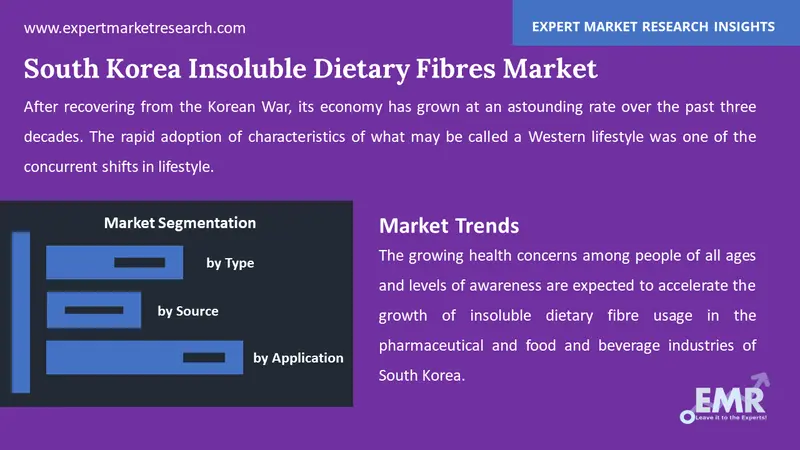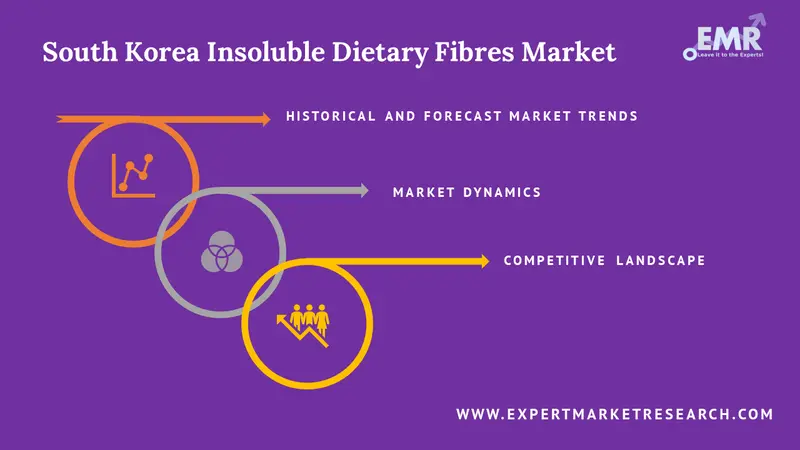
Consumer Insights
Uncover trends and behaviors shaping consumer choices today
Procurement Insights
Optimize your sourcing strategy with key market data
Industry Stats
Stay ahead with the latest trends and market analysis.
The South Korea insoluble dietary fibres market size reached a value of more than USD 96.23 Million in 2025. The South Korea insoluble dietary fibre industry is expected to grow at a CAGR of 7.30% between 2026 and 2035, reaching a value of around USD 194.67 Million by 2035.
Base Year
Historical Period
Forecast Period
Compound Annual Growth Rate
7.3%
Value in USD Million
2026-2035
*this image is indicative*
Insoluble fibre is also known as roughage. Unlike soluble fibre, it is insoluble in nature and does not dissolve in water. It is found in foods like vegetables, whole grains, and wheat bran, among others. Insoluble fibre makes the faeces bulky which aids their smooth movement in the intestine.
Diverticulitis is a disorder that causes pouches in the intestinal walls to become inflamed and infected. The diverticular disease typically develops in conjunction with a diet poor in fibre. A substantial intake of insoluble fibre lowers the incidence of diverticular illness by around 40% . Additionally, consuming more dietary fibre lowers the chance of developing several malignancies, including colon cancer. According to some studies insoluble fibre speeds up the body's removal of waste. As a result, the exposure to hazardous chemicals that form as a by-product of digestion is decreased. Insoluble fibre also aids in preserving the ideal pH balance in the intestines. This stops bacteria from producing cancer-causing chemicals as a result. These health benefits urge customers to consume insoluble fibre frequently, thereby augmenting the insoluble dietary fibres market in South Korea.
Universal tendencies include a quickening transition from communicable to non-communicable illnesses and parallel changes in food, exercise, and body composition. Compared to the majority of Asian countries, South Korea underwent an economic transition early. After recovering from the Korean War, its economy has grown at an astounding rate over the past three decades. The rapid adoption of characteristics of what may be called a Western lifestyle was one of the concurrent shifts in lifestyle. Fast-food and beverage establishments were launched and quickly gained popularity, particularly among the younger set. However, campaigns to preserve traditional food staples and eating habits also emerged during the same period. This confluence of circumstances caused the dietary transition in South Korea to take on its distinctive form owing to high disposable income and high living standards.
“South Korea Insoluble Dietary Fibres Market Report and Forecast 2026-2035” offers a detailed analysis of the market based on the following segments:
Market Breakup by Type
Market Breakup by Source

Read more about this report - REQUEST FREE SAMPLE COPY IN PDF
Insoluble fibre efficiently supports the digestive system by increasing the bulk of stools and facilitating their excretion. They retain their physical as well as functional properties even after hours of cooking. Cellulose, hemicellulose, and lignin are the primary components of insoluble fibre and resistant starch. Constipation is a typical gastrointestinal ailment, particularly in the elderly and is known to be relieved and prevented by consuming fibre. As it moves through the gastrointestinal system, insoluble fibre binds water. This lessens the likelihood of constipation by making faeces thicker and softer. Stools with more bulk move more easily. Such health benefits motivate consumers to consume a variety of insoluble fibres depending on their needs and thereby propel the market of insoluble dietary fibre in South Korea.
Insoluble fibre may be found in abundance in whole-wheat products, including flour, wheat bran, nuts, beans, and vegetables like potatoes, cauliflower, and green beans. Consuming foods with added fibre, such as cereal, granola bars, yoghurt, and ice cream, is another approach to increasing the daily intake of fibre. Typically, the additional fibre is usually inulin or chicory root. While it's preferable to obtain fibre through whole meals, those who might benefit from additional insoluble fibre, such as those who want to avoid constipation, have the option of doing so by taking fibre supplements. Fibre is taken from natural sources, such as psyllium husk, to create supplements, that provide fibre in concentrated amounts.
The preference for functional foods and beverages is escalating quickly, leading to increased consumption of prebiotics in the country. The growing health concerns among people of all ages and levels of awareness are expected to accelerate the growth of insoluble dietary fibre usage in the pharmaceutical and food and beverage industries of South Korea. Furthermore, the high demand for weight management items, especially among the youth, offers more opportunities for the market players to launch more of these products in the South Korean market. Insoluble fibres such as roquette pea hulls are extensively used in the pet food industry, and their market is increasing due to the rising demand for pet diet management products. These varied applications of insoluble fibre in numerous industries aid the growth of the market in South Korea.

Read more about this report - REQUEST FREE SAMPLE COPY IN PDF
The comprehensive EMR report provides an in-depth assessment of the market based on the Porter's five forces model along with giving a SWOT analysis. The report gives a detailed analysis of the following key players in the South Korea insoluble dietary fibres market, covering their competitive landscape and latest developments like mergers, acquisitions, investments and expansion plans.
Ingredion is one of the leading providers of ingredient solutions worldwide. The business provides a variety of sectors, including those in food, soft drinks, brewing, pharmaceuticals, corrugating, paper, and textiles. Ingredion has company-owned businesses, partnerships, alliances, and technology licences spread across the world. The business is headquartered in Westchester, Illinois, in the United States of America.
Roquette is a family-owned industry pioneer in plant-based products, a prominent supplier of pharmaceutical excipients, and a forerunner in plant proteins. Roquette has developed into the fourth-ranked starch producer globally and the leader in Europe for starch production. In order to be used in the food, pharmaceutical, paper, textile, animal feed, chemical, plastics, and fermentation industries, the generated starches and sugars are subsequently transformed into industrial components. With a global workforce of over 8,000 individuals and operations in over 100 nations, the firm presently generates a 3.9 billion euro annual revenue . Its founding location and main office are both in Lestrem, France.
*Please note that this is only a partial list; the complete list of key players is available in the full report. Additionally, the list of key players can be customized to better suit your needs.*
Other market players include Dupont (Nutrition & Biosciences), Cargill, Incorporated, and Tate & Lyle PLC, among others.




*While we strive to always give you current and accurate information, the numbers depicted on the website are indicative and may differ from the actual numbers in the main report. At Expert Market Research, we aim to bring you the latest insights and trends in the market. Using our analyses and forecasts, stakeholders can understand the market dynamics, navigate challenges, and capitalize on opportunities to make data-driven strategic decisions.*
Get in touch with us for a customized solution tailored to your unique requirements and save upto 35%!
In 2025, the South Korea market attained a value of nearly USD 96.23 Million.
The market is projected to grow at a CAGR of 7.30% between 2026 and 2035.
The South Korea insoluble fibre market is estimated to witness a healthy growth in the forecast period of 2026-2035 to reach USD 194.67 Million by 2035.
The increasing disposable income, improved living standards, changes in lifestyle, and the growing no. of fast food and beverage establishment are the major drivers of the insoluble dietary fibre industry in South Korea.
The health benefits of consuming insoluble dietary fibre and its awareness among the general population are the leading trends of the insoluble dietary fibre industry in South Korea.
The dominant types of insoluble dietary fibre in the industry are cellulose, hemicellulose, chitin and chitosan, lignin, fibre/bran, and resistant starch, among others.
The major players in the industry are Ingredion Incorporated, Roquette Frères., Dupont (Nutrition & Biosciences), Cargill, Incorporated, and Tate & Lyle PLC, among others.
Explore our key highlights of the report and gain a concise overview of key findings, trends, and actionable insights that will empower your strategic decisions.
| REPORT FEATURES | DETAILS |
| Base Year | 2025 |
| Historical Period | 2019-2025 |
| Forecast Period | 2026-2035 |
| Scope of the Report |
Historical and Forecast Trends, Industry Drivers and Constraints, Historical and Forecast Market Analysis by Segment:
|
| Breakup by Type |
|
| Breakup by Source |
|
| Breakup by Application |
|
| Market Dynamics |
|
| Competitive Landscape |
|
| Companies Covered |
|
Datasheet
One User
USD 2,499
USD 2,249
tax inclusive*
Single User License
One User
USD 3,999
USD 3,599
tax inclusive*
Five User License
Five User
USD 4,999
USD 4,249
tax inclusive*
Corporate License
Unlimited Users
USD 5,999
USD 5,099
tax inclusive*
*Please note that the prices mentioned below are starting prices for each bundle type. Kindly contact our team for further details.*
Flash Bundle
Small Business Bundle
Growth Bundle
Enterprise Bundle
*Please note that the prices mentioned below are starting prices for each bundle type. Kindly contact our team for further details.*
Flash Bundle
Number of Reports: 3
20%
tax inclusive*
Small Business Bundle
Number of Reports: 5
25%
tax inclusive*
Growth Bundle
Number of Reports: 8
30%
tax inclusive*
Enterprise Bundle
Number of Reports: 10
35%
tax inclusive*
How To Order

Select License Type
Choose the right license for your needs and access rights.

Click on ‘Buy Now’
Add the report to your cart with one click and proceed to register.

Select Mode of Payment
Choose a payment option for a secure checkout. You will be redirected accordingly.
Gain insights to stay ahead and seize opportunities.

Get insights & trends for a competitive edge.

Track prices with detailed trend reports.

Analyse trade data for supply chain insights.

Leverage cost reports for smart savings

Enhance supply chain with partnerships.

Connect For More Information
Our expert team of analysts will offer full support and resolve any queries regarding the report, before and after the purchase.
Our expert team of analysts will offer full support and resolve any queries regarding the report, before and after the purchase.
We employ meticulous research methods, blending advanced analytics and expert insights to deliver accurate, actionable industry intelligence, staying ahead of competitors.
Our skilled analysts offer unparalleled competitive advantage with detailed insights on current and emerging markets, ensuring your strategic edge.
We offer an in-depth yet simplified presentation of industry insights and analysis to meet your specific requirements effectively.
Share